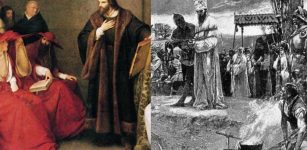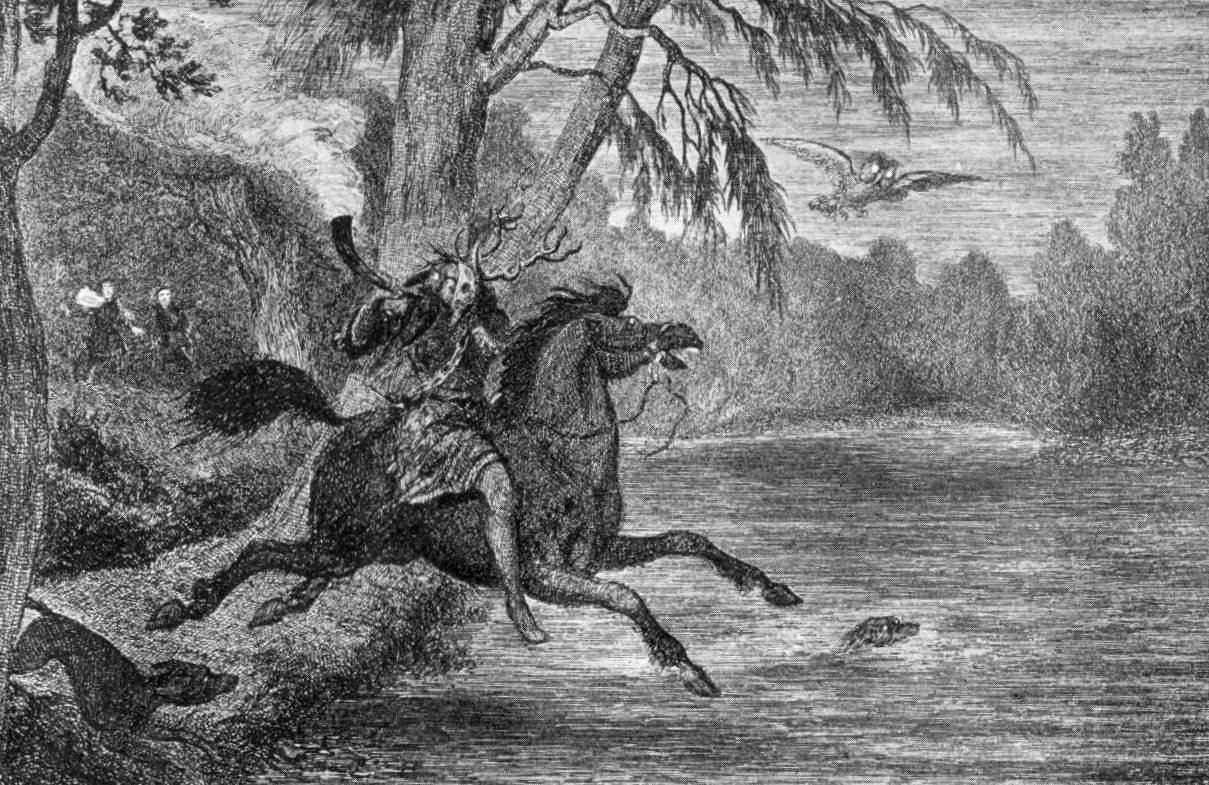Herne The Hunter – The Horned God And Lord Of The Forest In British Mythology
Ellen Lloyd - AncientPages.com - Little is known about a mysterious, mythical creature called Herne the Hunter who was said to reside in Windsor Forest and Great Park in the English county of Berkshire.
The original source for many of the tales told of Herne remains unknown. Herne the Hunter was mentioned by William Shakepeare who described him as "a spirit" and "sometime a keeper … in Windsor forest" who is seen to "walk round about an oak, with great ragged horns" at midnight during winter-time.
The Merry Wives of Windsor’ : William Shakespeare
‘There is an old tale goes, that Herne the hunter,
Sometime a keeper here in Windsor forest,
Doth all the winter time at still midnight,
Walk around about an oak, with great ragg’d horns;
And there he blasts the tree, and takes the cattle;
And makes milch-kine yield blood, and shakes a chain
In a most hideous and dreadful manner.’
The Merry Wives of Windsor : William Shakespeare
‘Why, yet there want not many, that do fear
In deep of night to walk by this Herne’s oak.’
Herne the Hunter in British Mythology
Is there a true story behind the legend of Herne the Hunter? There are several versions of an old tale revealing the faith of Herne, who was a huntsman employed by King Richard II.
Soon some men became jealous of his status and accused him of poaching on the King's land. Falsely charged with treason, Herne became an outcast among his former friends. Legend tells that in despair, he hung himself from an oak tree which later became known as Herne's Oak.
There is also another version of the story. According to which Herne was fatally wounded while saving King Richard from a charging stag. He was miraculously cured by a stranger, who tied the antlers of a dead stag to the dying man's brow. The stranger demanded in payment all Herne's skill in venery. Crazed by the loss of that skill in the craft he loved, Herne fled to the forest, and hanged himself, again from the oak tree. However, every night he rides once more leading a spectral hunt, chasing the game of Windsor Forest.
On August 31 1863 the famous Windsor Oak fell from natural causes but was soon replaced by a new young Oaktree by Queen Victoria on the same spot.
Why was Herne the Hunter called Lord of the Forest?
In the area around Berkshire, Herne is depicted wearing the antlers of a great stag. He is considered a great hunter who possessed divine skills. Herne's antlers connect him to the deer, which was given a position of great honor. Legends tell that he carried a great horn and a wooden bow, riding a mighty black horse and accompanied by a pack of baying hounds. If someone crossed his path, they were swept up in it, and often taken away, destined to ride with him for eternity.
Herne with his steed, hounds and owl, observed by the Duke of Richmond and the Earl of Surrey, in Harrison Ainsworth's Windsor Castle, illustrated by George Cruikshank, c.1843.
Encountering Herne the Hunter is a bad omen, especially to the royal family. According to local legend, Herne only appears in Windsor Forest when needed, such as in times of national crisis.
Was Herne the Hunter Cernunnos, the Celtic horned god or the Norse god Odin?
There many ancient accounts of people and gods with horns. Horns represent the primal power of nature, express the unstoppable power and the majesty and throughout human history, horns have been synonymous with this strength.
The antlered god Cernunnos, whose cult is most widely attested, is usually represented with the horns of a ram or a deer, squatting on the ground, and his posture indeed recalls that of the Buddha. with a humanoid body in Celtic myth.
See also:
Orang Bunian: Mysterious Invisible Whistle People Living In Forests In Malay Folklore
Forest In Ancient Beliefs: Powerful Realm Of Good And Evil, Ghosts, Gods And Monsters
Gilgamesh And Enkidu Undertake A Dangerous Mission To Hunt Forest Giant Humbaba
There is no one particular myth concerning him, for only his image remains. The 'cer' part of his name, relating to his antlers, means ‘horned’. He is found mainly in sculpted statues and reliefs from ancient Gaul (modern France), but the clearest image is found on the silver votive cauldron, the Gundestrup Cauldron, which is described in one of our articles.
Horned animal deities played a significant role in the early civilizations of the ancient world, where the power and mysteries of the Sumerian bull gods of Sumeria and the Egyptian ram and bull gods of were transmitted into the civilizations of the ancient world.
Cernunnos, Celtic horned god. Image credit: Wikipedia
The Windsor Forest area has a heavy Saxon influence. In the Early Middle Ages, Windsor Forest came under the control of the pagan Angles who worshiped their own pantheon of gods, including Woden, who was sometimes depicted as horned, and whose Norse equivalent Odin rode across the night sky with his own Wild Hunt and hanged himself on the world tree Yggdrasil to learn the secret of the runic alphabet. It has been suggested that the name Herne is derived from the title Herian, a title used for Woden in his role as leader of fallen warriors.
Dr. Margaret Alice Murray, (1863-1963), who was a prominent British Egyptologist and anthropologist wrote in her book God of the Witches that Herne is a manifestation of Cernunnos, the Celtic horned god. The facts that the existence of Herne the Hunter has only been claimed in Berkshire, and not in the rest of the Windsor Forest area, suggests that Herne should be considered a "localized" god and could indeed be the Berkshire interpretation of Cernunnos.
Written by: Ellen Lloyd AncientPages.com
Copyright © AncientPages.com & Ellen Lloyd All rights reserved. This material may not be published, broadcast, rewritten or redistributed in whole or part without the express written permission of AncientPages.com and Ellen Lloyd
More From Ancient Pages
-
 Shattering The Myth Of Men As Hunters And Women As Gatherers
Archaeology | Jun 29, 2023
Shattering The Myth Of Men As Hunters And Women As Gatherers
Archaeology | Jun 29, 2023 -
 Archaeologists Use Laser Technology To Create Digital Models Of Ancient Artifacts
Archaeology | Jan 28, 2016
Archaeologists Use Laser Technology To Create Digital Models Of Ancient Artifacts
Archaeology | Jan 28, 2016 -
 Remarkable Man-Made Underwater Structures Could Rewrite History Of Wisconsin
Featured Stories | Aug 22, 2018
Remarkable Man-Made Underwater Structures Could Rewrite History Of Wisconsin
Featured Stories | Aug 22, 2018 -
 Ancient Road Used By The Teutonic Knights Discovered In A Lake In Poland
Archaeology | Nov 8, 2021
Ancient Road Used By The Teutonic Knights Discovered In A Lake In Poland
Archaeology | Nov 8, 2021 -
 Colchester Vase Offers ‘Startling’ Evidence Of Gladiator Fights In Roman Britain
Archaeology | Mar 6, 2023
Colchester Vase Offers ‘Startling’ Evidence Of Gladiator Fights In Roman Britain
Archaeology | Mar 6, 2023 -
 On This Day In History: First Battle Of Gaza Was Fought – On March 26, 1917
News | Mar 26, 2017
On This Day In History: First Battle Of Gaza Was Fought – On March 26, 1917
News | Mar 26, 2017 -
 Scientific Disagreement Over The Bronze Age Tin Ingots From The Uluburun Shipwreck
Archaeology | Sep 25, 2023
Scientific Disagreement Over The Bronze Age Tin Ingots From The Uluburun Shipwreck
Archaeology | Sep 25, 2023 -
 Ancient Knowledge Of Other Worlds And An ‘Impossible’ Being That Shouldn’t Exist
Featured Stories | May 6, 2020
Ancient Knowledge Of Other Worlds And An ‘Impossible’ Being That Shouldn’t Exist
Featured Stories | May 6, 2020 -
 Evolution Of Paleodiet At Neolithic Qujialing Site Unveiled By Scientists
Archaeology | Nov 30, 2022
Evolution Of Paleodiet At Neolithic Qujialing Site Unveiled By Scientists
Archaeology | Nov 30, 2022 -
 Jan Hus: Czech Reformer And Bohemian Religious Leader Was Burned At Stake For Heresy
Featured Stories | Dec 17, 2019
Jan Hus: Czech Reformer And Bohemian Religious Leader Was Burned At Stake For Heresy
Featured Stories | Dec 17, 2019 -
 Secrets Of The Serpent Kingdom Revealed On Maya ‘Game Of Thrones’ Altar
Archaeology | Sep 15, 2018
Secrets Of The Serpent Kingdom Revealed On Maya ‘Game Of Thrones’ Altar
Archaeology | Sep 15, 2018 -
 Our 7-Day Week Can Be Traced To Babylonians Who Started Using It 4,000 Years Ago
Ancient History Facts | Nov 7, 2016
Our 7-Day Week Can Be Traced To Babylonians Who Started Using It 4,000 Years Ago
Ancient History Facts | Nov 7, 2016 -
 Mystery Of The Candelabrum: One Of The Most Enigmatic Ancient Giant Ground Drawings In The World
Featured Stories | Nov 2, 2015
Mystery Of The Candelabrum: One Of The Most Enigmatic Ancient Giant Ground Drawings In The World
Featured Stories | Nov 2, 2015 -
 Life Of Galilean Sages Described On 1,800-Year-Old Hebrew Inscriptions Can Confirm Ancient Legends
Archaeology | Feb 25, 2017
Life Of Galilean Sages Described On 1,800-Year-Old Hebrew Inscriptions Can Confirm Ancient Legends
Archaeology | Feb 25, 2017 -
 Babylonians And Sumerians Had Advanced Knowledge Of Astronomy
Civilizations | Feb 28, 2017
Babylonians And Sumerians Had Advanced Knowledge Of Astronomy
Civilizations | Feb 28, 2017 -
 Discovery At Fujiwarakyu Palace Complex Offers Better Glimpse Of 7th-Century Japan
Archaeology | Oct 21, 2015
Discovery At Fujiwarakyu Palace Complex Offers Better Glimpse Of 7th-Century Japan
Archaeology | Oct 21, 2015 -
 On This Day In History: Leon Trotsky Was Assassinated – On August 20, 1940
News | Aug 20, 2016
On This Day In History: Leon Trotsky Was Assassinated – On August 20, 1940
News | Aug 20, 2016 -
 Yggdrasil: Eternal And Sacred Tree Of Life In Norse Mythology
Featured Stories | Sep 22, 2016
Yggdrasil: Eternal And Sacred Tree Of Life In Norse Mythology
Featured Stories | Sep 22, 2016 -
 Mysterious Stone Age Cemetery Found Near The Arctic – Why Are The Graves Empty?
Archaeology | Dec 4, 2023
Mysterious Stone Age Cemetery Found Near The Arctic – Why Are The Graves Empty?
Archaeology | Dec 4, 2023 -
 Karakorum – Genghis Khan’s Headquarters And Important City In History Of Silk Road
Civilizations | Mar 26, 2016
Karakorum – Genghis Khan’s Headquarters And Important City In History Of Silk Road
Civilizations | Mar 26, 2016





